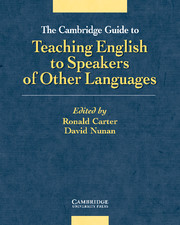Book contents
- Frontmatter
- Contents
- List of figures
- List of abbreviations
- Acknowledgements
- List of contributors
- Introduction
- Chapter 1 Listening
- Chapter 2 Speaking
- Chapter 3 Reading
- Chapter 4 Writing
- Chapter 5 Grammar
- Chapter 6 Vocabulary
- Chapter 7 Discourse
- Chapter 8 Pronunciation
- Chapter 9 Materials development
- Chapter 10 Second language teacher education
- Chapter 11 Psycholinguistics
- Chapter 12 Second language acquisition
- Chapter 13 Bilingualism
- Chapter 14 Sociolinguistics
- Chapter 15 Computer-assisted language learning
- Chapter 16 Observation
- Chapter 17 Classroom interaction
- Chapter 18 English for academic purposes
- Chapter 19 English for specific purposes
- Chapter 20 Assessment
- Chapter 21 Evaluation
- Chapter 22 Syllabus design
- Chapter 23 Language awareness
- Chapter 24 Language learning strategies
- Chapter 25 Task-based language learning
- Chapter 26 Literature in the language classroom
- Chapter 27 Genre
- Chapter 28 Programme management
- Chapter 29 Intercultural communication
- Chapter 30 On-line communication
- Postscript: The ideology of TESOL
- Glossary
- References
- Index
Chapter 10 - Second language teacher education
Published online by Cambridge University Press: 07 September 2010
- Frontmatter
- Contents
- List of figures
- List of abbreviations
- Acknowledgements
- List of contributors
- Introduction
- Chapter 1 Listening
- Chapter 2 Speaking
- Chapter 3 Reading
- Chapter 4 Writing
- Chapter 5 Grammar
- Chapter 6 Vocabulary
- Chapter 7 Discourse
- Chapter 8 Pronunciation
- Chapter 9 Materials development
- Chapter 10 Second language teacher education
- Chapter 11 Psycholinguistics
- Chapter 12 Second language acquisition
- Chapter 13 Bilingualism
- Chapter 14 Sociolinguistics
- Chapter 15 Computer-assisted language learning
- Chapter 16 Observation
- Chapter 17 Classroom interaction
- Chapter 18 English for academic purposes
- Chapter 19 English for specific purposes
- Chapter 20 Assessment
- Chapter 21 Evaluation
- Chapter 22 Syllabus design
- Chapter 23 Language awareness
- Chapter 24 Language learning strategies
- Chapter 25 Task-based language learning
- Chapter 26 Literature in the language classroom
- Chapter 27 Genre
- Chapter 28 Programme management
- Chapter 29 Intercultural communication
- Chapter 30 On-line communication
- Postscript: The ideology of TESOL
- Glossary
- References
- Index
Summary
Introduction
SECOND LANGUAGE TEACHER EDUCATION AS SHIFTING CONSTRUCT
Second language (L2) teacher education describes the field of professional activity through which individuals learn to teach L2s. In terms commonly used in the field, these formal activities are generally referred to as teacher training, while those that are undertaken by experienced teachers, primarily on a voluntary, individual basis, are referred to as teacher development. I return to this issue of nomenclature later on (see ‘the role of input’); at this point, however, the reader should understand that the term teacher education refers to the sum of experiences and activities through which individuals learn to be language teachers. Those learning to teach – whether they are new to the profession or experienced, whether in pre- or in-service contexts – are referred to as teacher-learners (Kennedy 1991).
The shifting ground of terminology has plagued L2 teacher education for at least the past 30 years. The four-word concept has tended to be an awkward integration of subject-matter (‘second language’) and professional process (‘teacher education’). In this hybrid, the person of the teacher and the processes of learning to teach have often been overshadowed. As the relative emphasis has shifted, the focus among these four words has migrated from the content, the ‘second language’, to the person of the ‘teacher’, to the process of learning or ‘education’, thus capturing the evolution in the concept of L2 teacher education in the field.
- Type
- Chapter
- Information
- Publisher: Cambridge University PressPrint publication year: 2001
- 32
- Cited by



